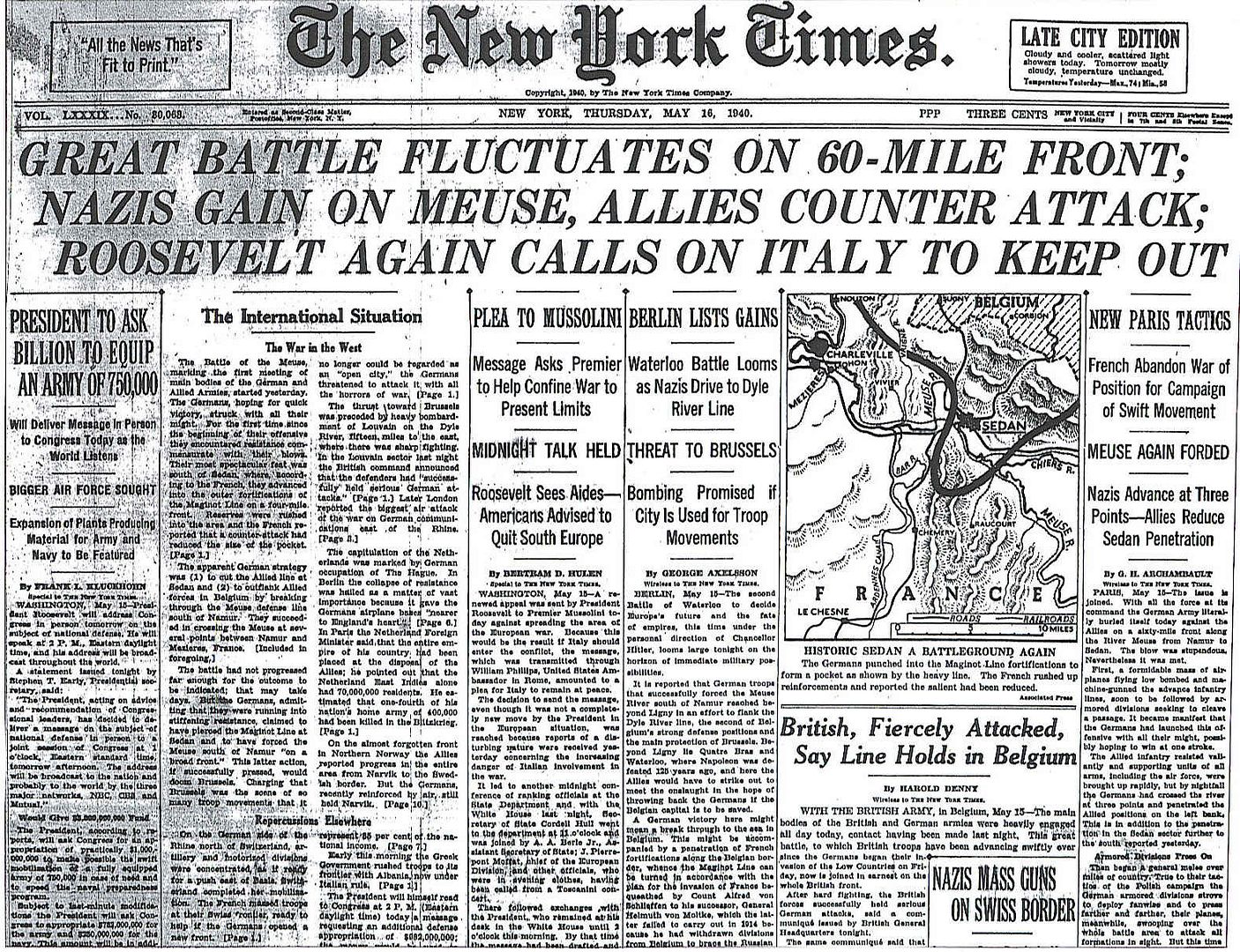
Posted on 05/16/2010 5:38:57 AM PDT by Homer_J_Simpson

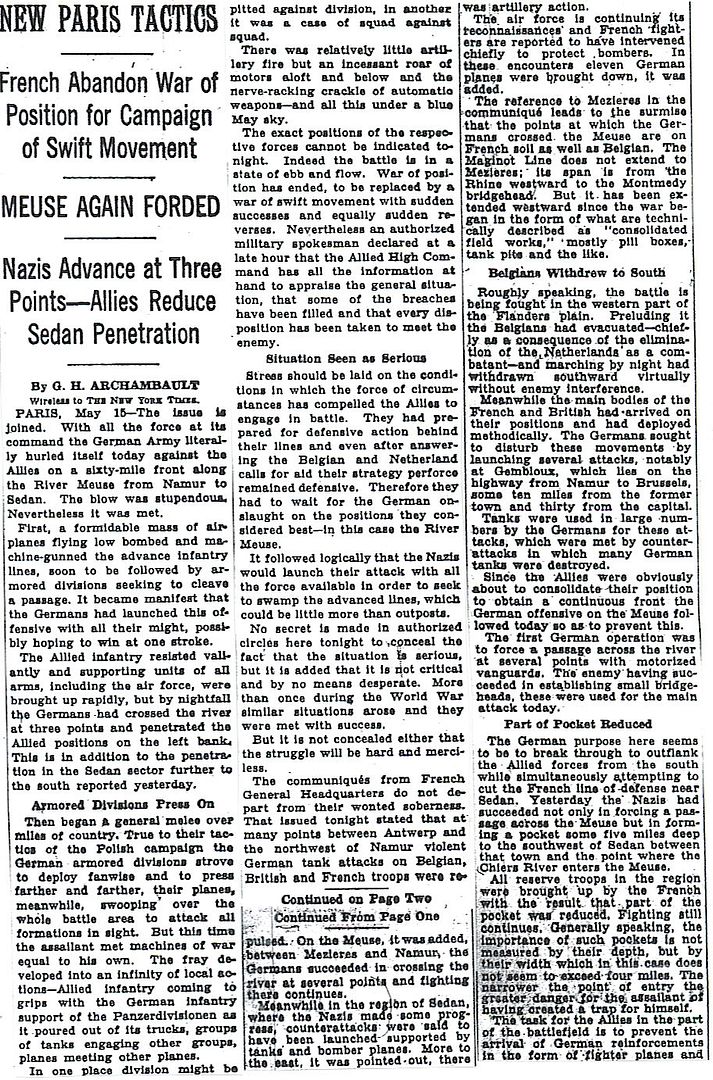
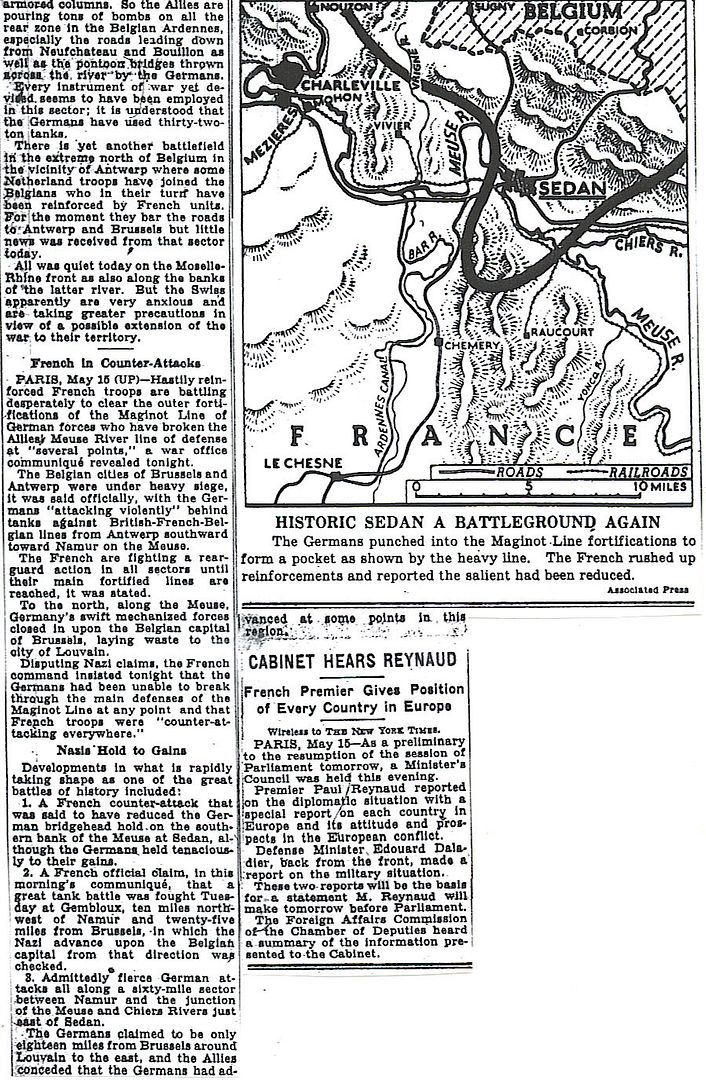
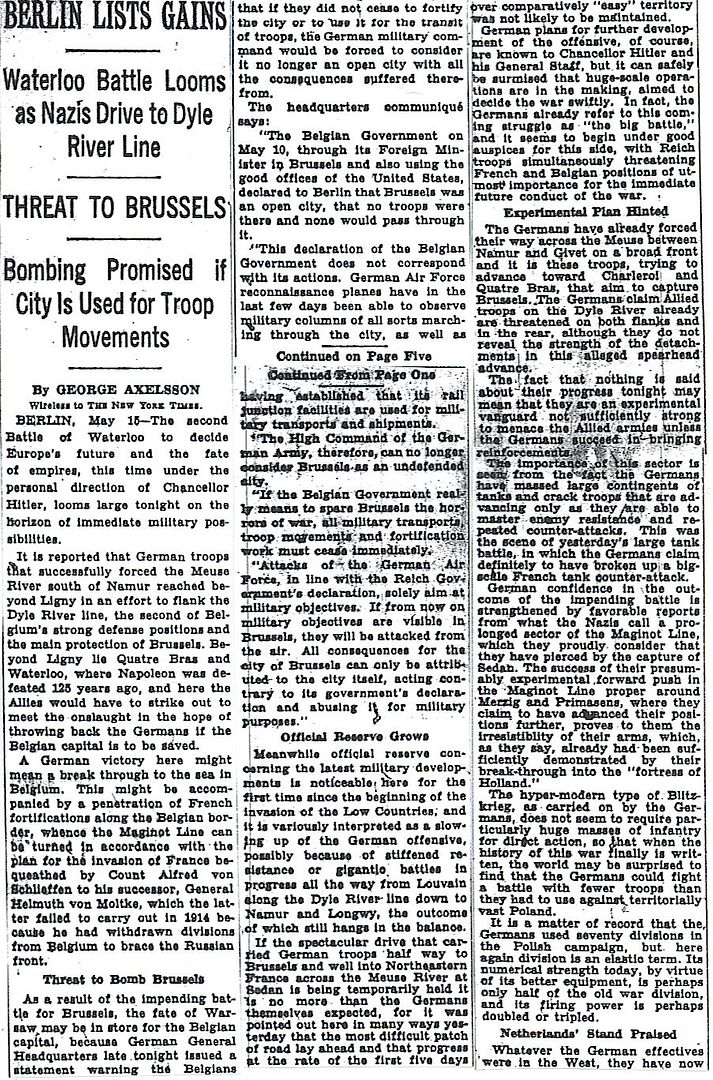
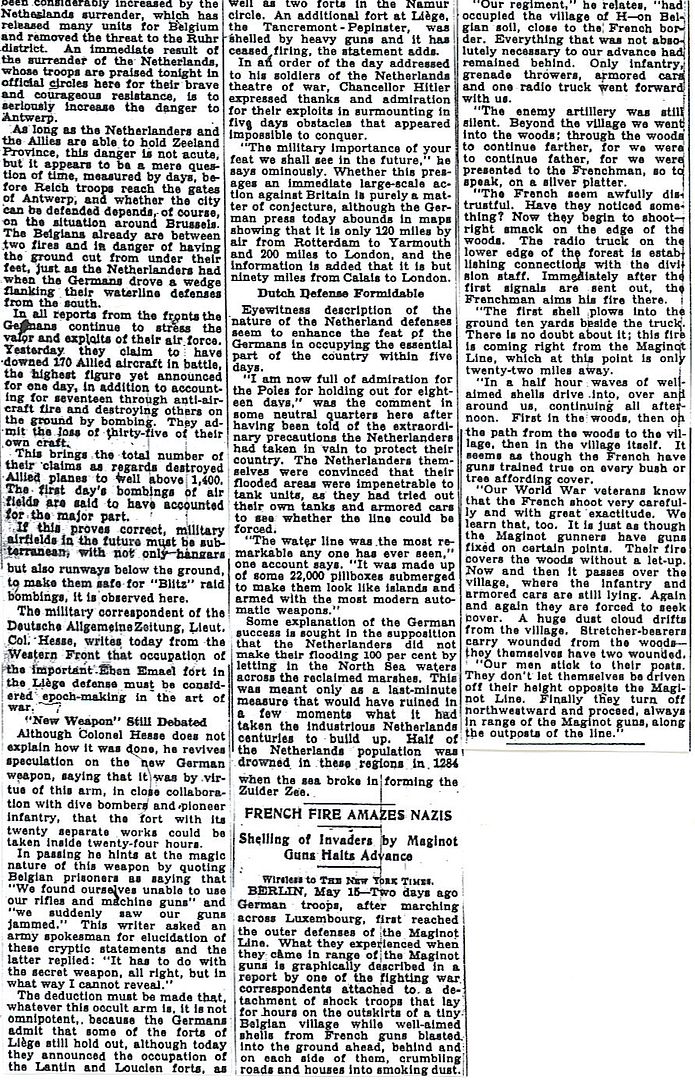
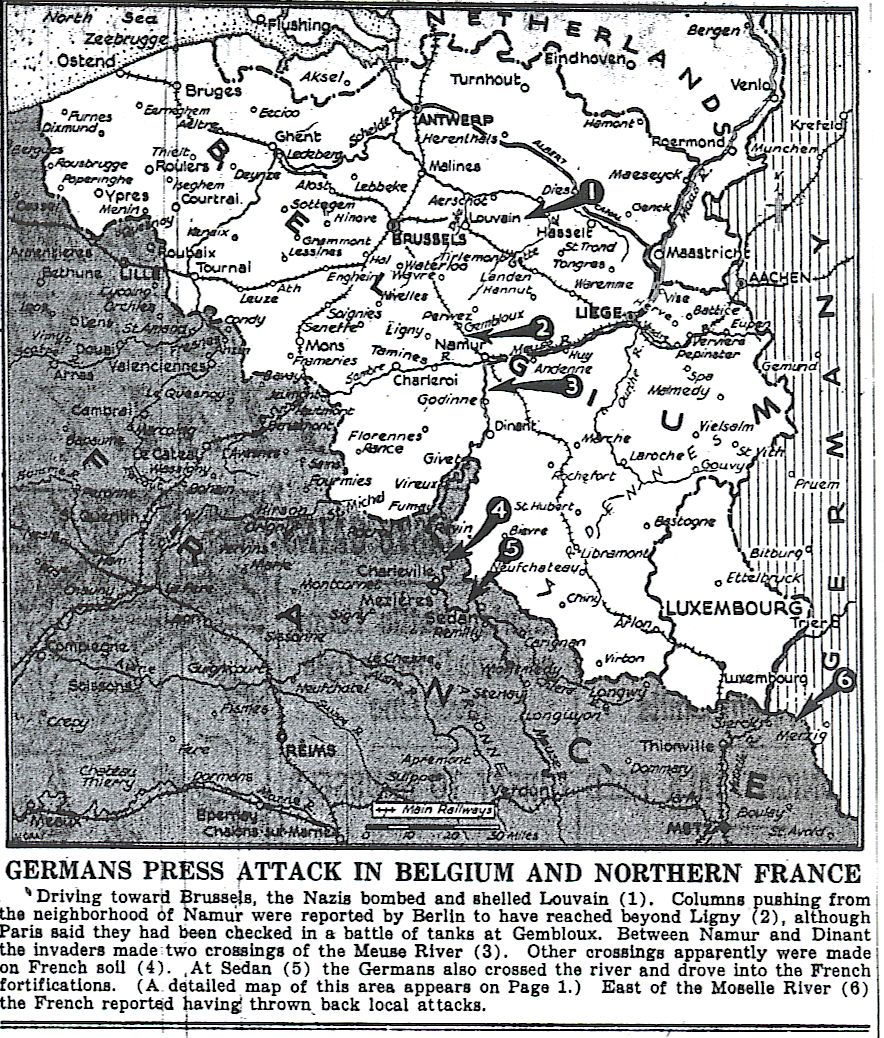
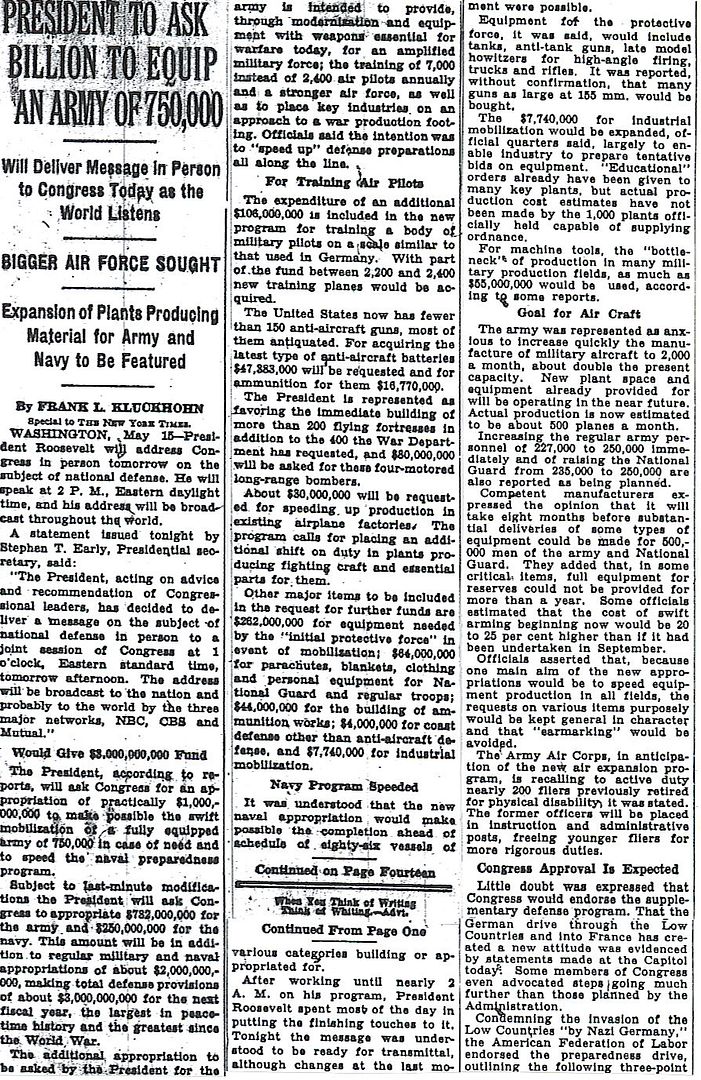
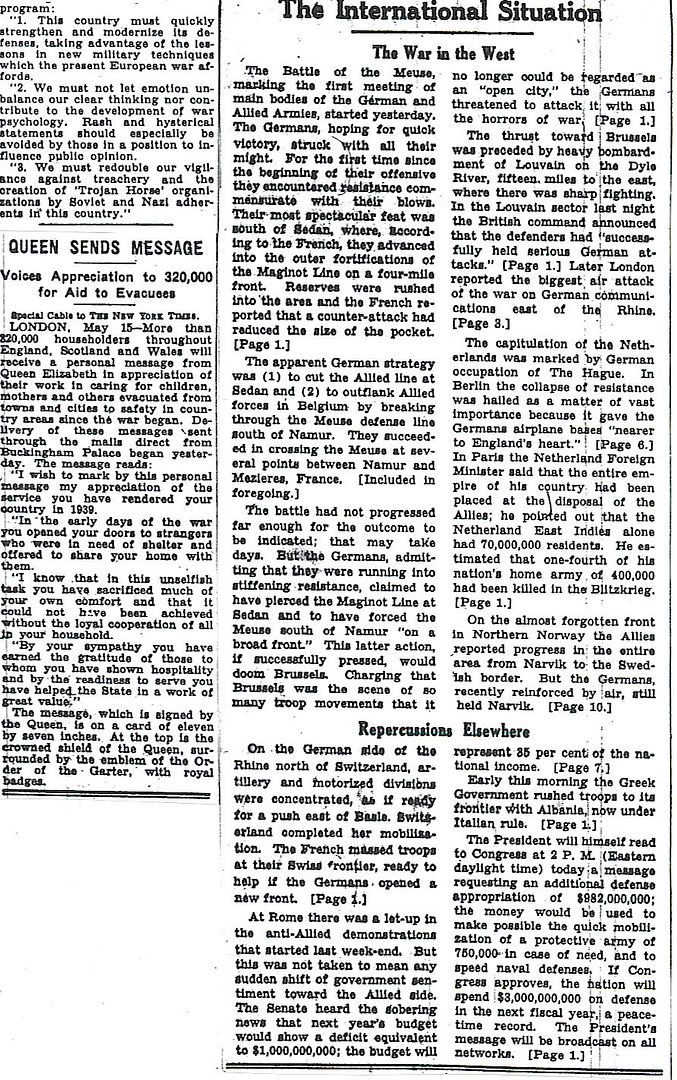
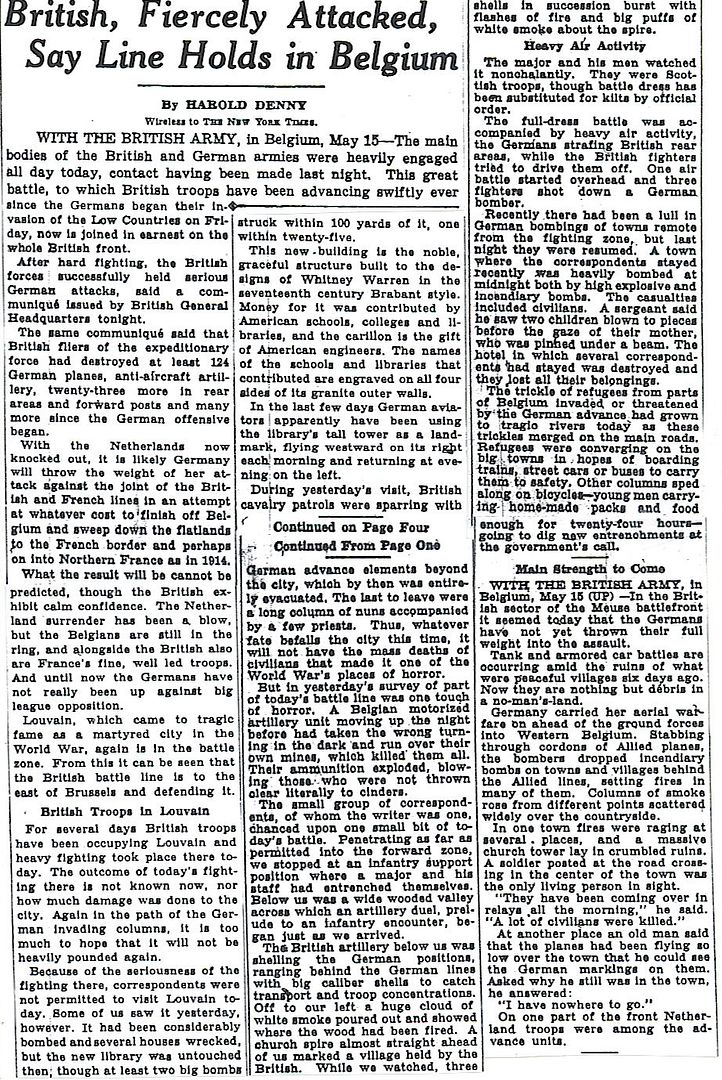
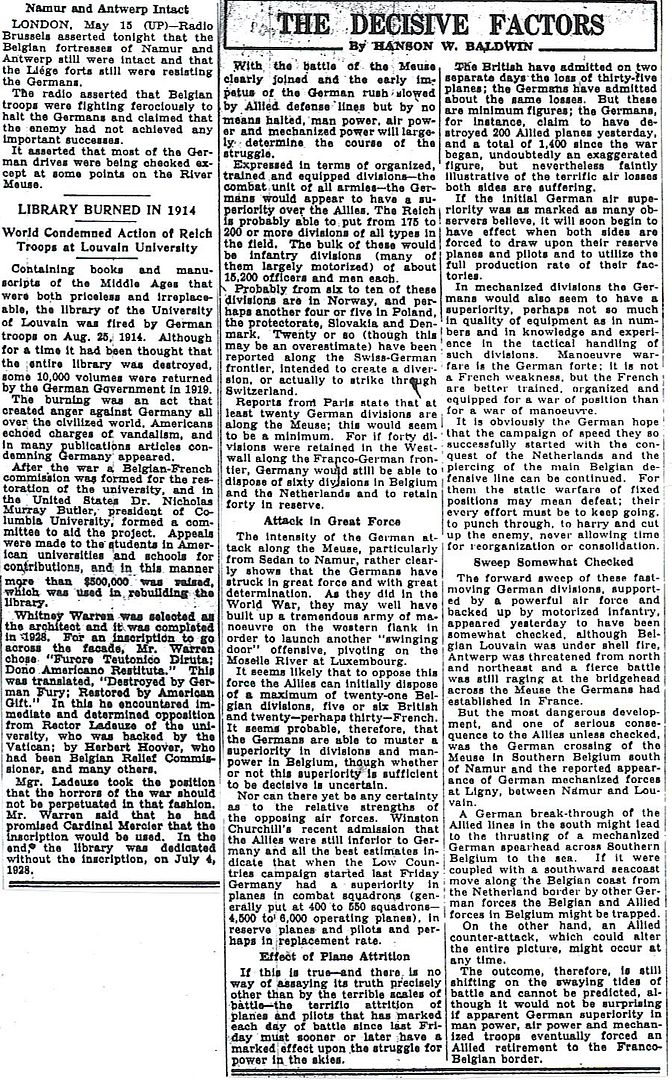
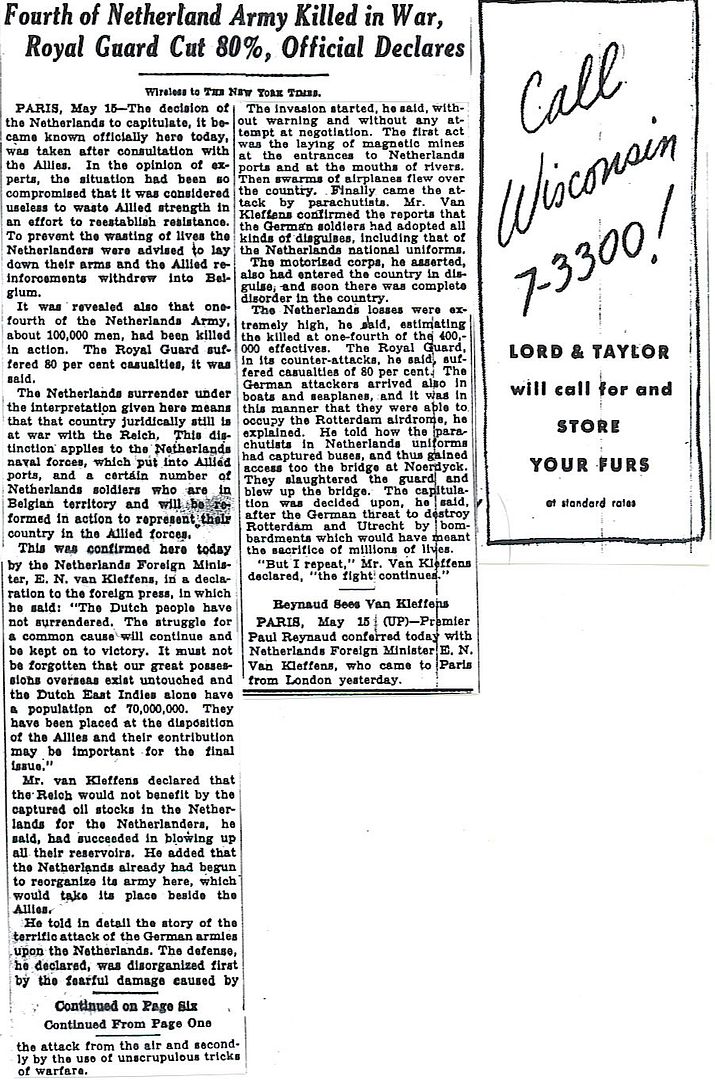
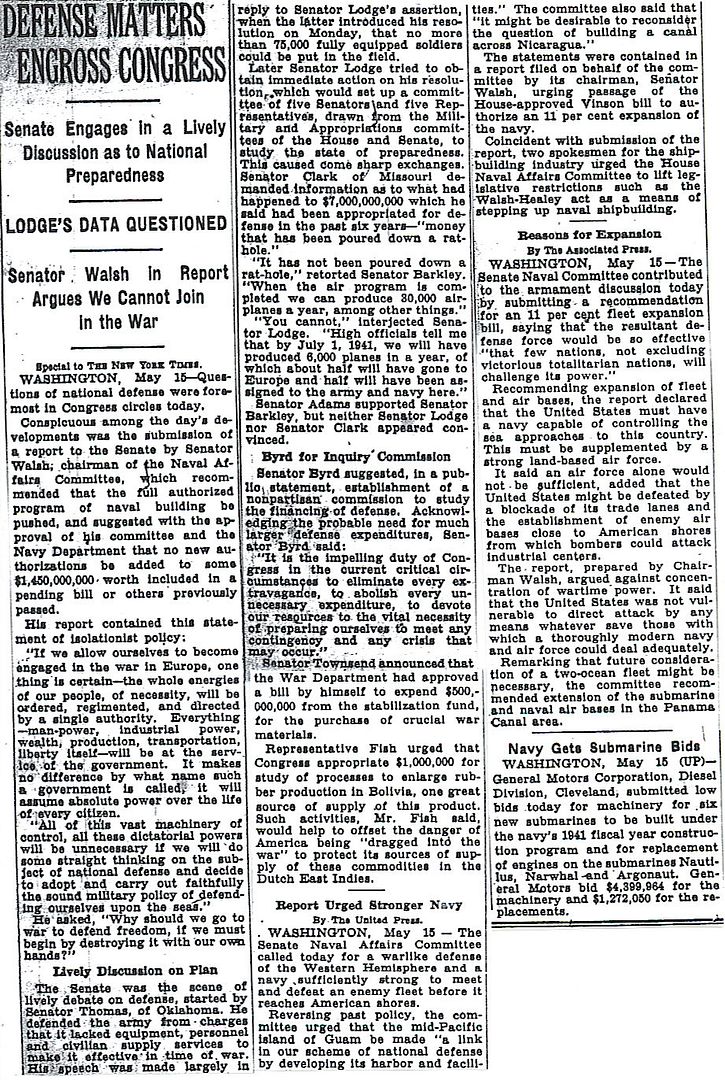
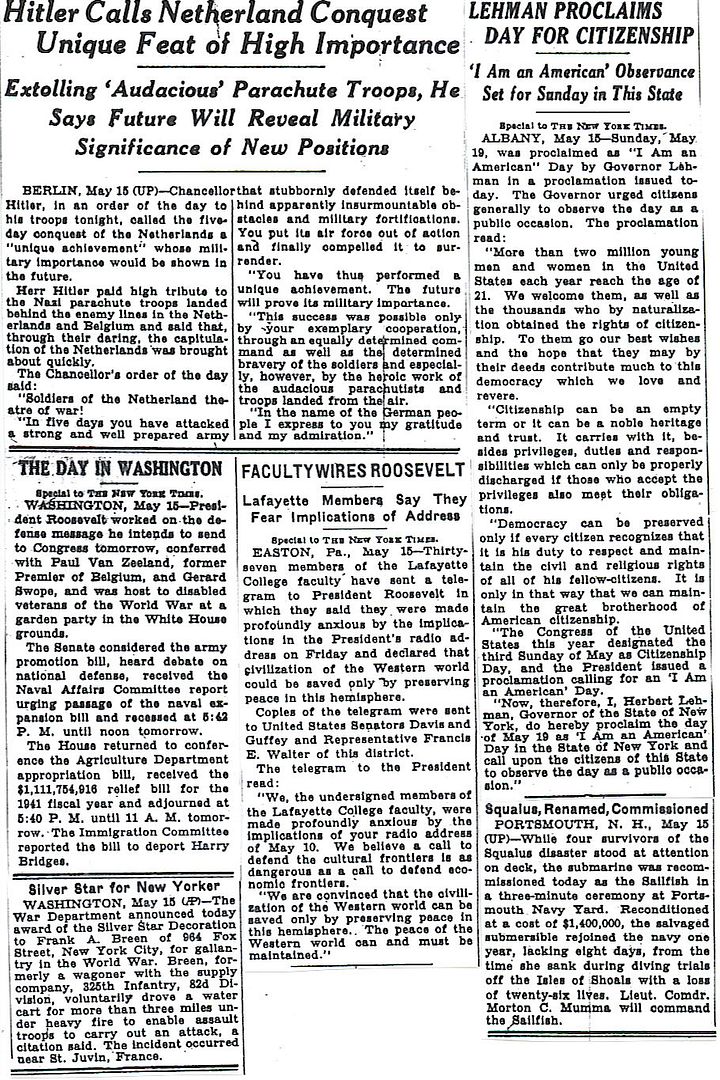
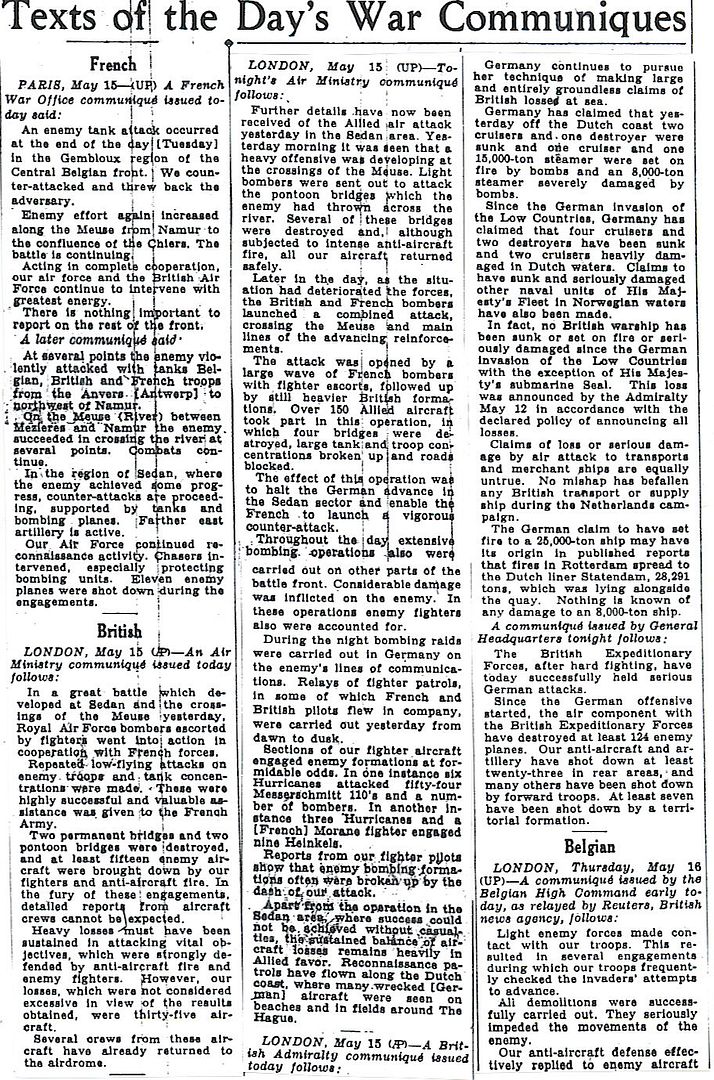
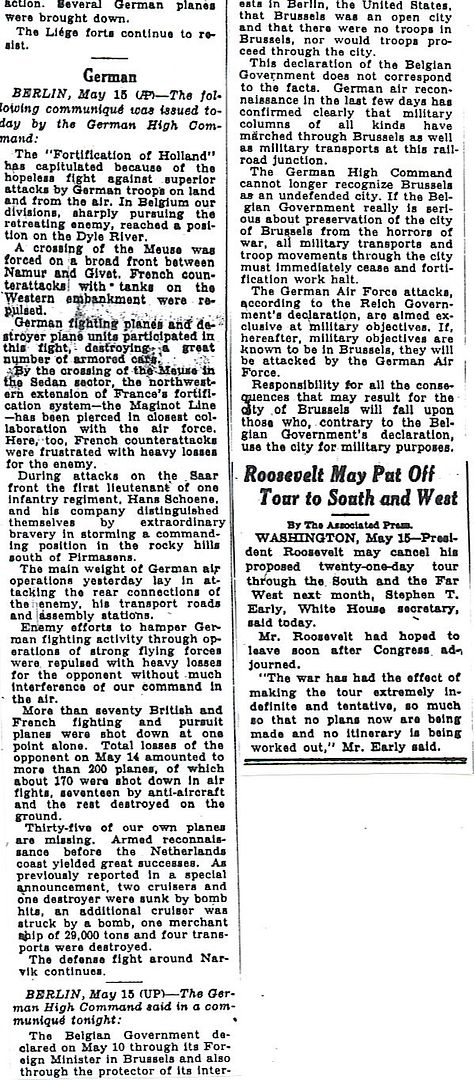
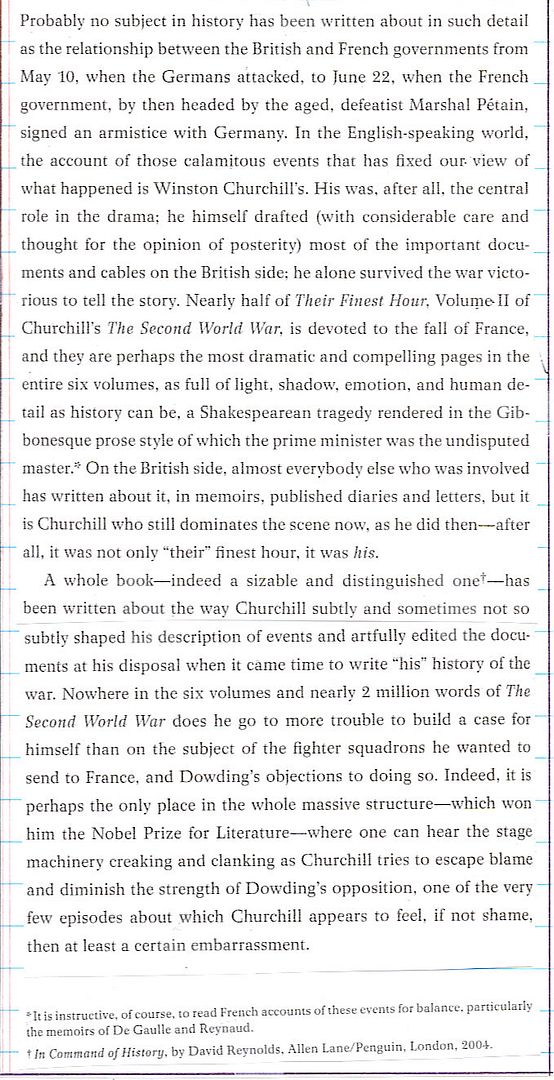
Michael Korda, With Wings Like Eagles: The Untold Story of the Battle of Britain
http://www.onwar.com/chrono/1940/may40/f16may40.htm
Allies withdraw from Belgium
Thursday, May 16, 1940 www.onwar.com
On the Western Front... The British and French forces which advanced into Belgium only a few days ago, begin to retreat to their former positions behind the line of the Scheldt. Units of Hoth’s 15th Panzer Corps, with Rommel’s 7th Panzer Division well to the fore, have reached just east of Cambrai to the south Guderian’s forces are moving on St. Quentin. Again a halt order is issued to the German tank forces because some of the more conservative minds at army headquarters cannot accept that the panzers can advance so far without exposing their flanks. In fact the speed of the advance has itself protected them and thrown the French into confusion.
In Paris... Perhaps the best indication of the German success is the conversation between Churchill and Gamelin in which Churchill asks where the strategic reserve is and is told that there is none, or at least none left. Outside the room where this meeting takes place French government employees are beginning to burn secret files.
In Washington... Roosevelt asks Congress to authorize the production of 50,000 military planes per year and for a $900,000,000 extraordinary credit to finance this massive operation.
http://homepage.ntlworld.com/andrew.etherington/month/thismonth/16.htm
May 16th, 1940
UNITED KINGDOM: RAF Bomber Command: 4 Group (Whitley). Bombing - road/rail communications and troops - Maastricht, Aachen. 77 Sqn. 6 aircraft. One returned early, six bombed. 102 Sqn. Three aircraft, all bombed.’
One KLM aircraft (a Fokker assembled Douglas DC-2) escapes the Netherlands and lands in the UK. It will be operated by KLM with the British registration G-AGBH. (Jack McKillop)
The War Cabinet meets in London and decides to send four more squadrons of Hurricane fighters to France immediately. This strips the defence of Britain to a mere 22 modern single seater fighter squadrons (about 250 aircraft) plus 9 squadrons with obsolete fighter aircraft. Air Chief Marshall Dowding had prescribed a minimum requirement of 52 squadrons necessary for the defence of Britain. Later that evening, after meeting with French Premier Reynaud, Minister of Defence Deladier and Generalissime Gamelin, Churchill orders that a further six squadrons of fighters be sent to France on the following day.
FRANCE: Paris: Churchill is shaken when Gamelin and Reynaud tell him that they have no military reserves left.
7th Panzer Division races 50 miles to Avesnes, decimating the French 1st Armoured Division en route. By evening, XLI Panzer Corps has reached the river Oise near Vervins, while farther south, XIX Panzer Corps as reached the river Serre.
Lord Gort, commander of the BEF, finds is force almost isolated on the Dyle Line. Corap’s 9th Army is no longer in position and the Belgians have left a gap on the left. A North African division of 1st Army crumbles leaving a new
3 mile gap on the right. Gort sends an officer to obtain a new plan from General Bilotte who responds with instructions to retire the line in stages to the Escaut (Scheldte) by May 17th. The BEF retreats under mild pressure from von Bocks troops while the Panzers race through the 50 mile wide gap where Corap’s 9th Army had been.
German spearheads are 60 miles west of Sedan, rolling along undefended open country.
British and French forces are now retreating to the former positions they occupied on May 10.
MAP
NORWEGIAN CAMPAIGN: (Mark Horan) At 1100, Lt.Cdr. C. L. G. Evans led 9 Skuas of 806 Squadron, each armed with a single 250 lb SAP and 4x20 lb bombs, off from HMS Sparrowhawk (RNAS Hatston) to attack warships at Bergen. The planned three Blenheim escort form 254 Squadron, RAF failed to join up, but it had no detrimental effect on the mission. Failing to find any warships, the Skuas attacked several oil storage tanks. All returned safely.
Meanwhile, with HMS Furious and Glorious still enroute, HMS Ark Royal continued her support of the forces ashore. At 0300, from position 67.59N, 09.8E, a nine plane striking force of Swordfish (three from 810, six from 820), each armed with 2x250 lb and 8x20 lb bombs, again led by Capt. RN. R. M. Skene, RM, was dispatched to attack enemy troops and stores reported on the Hemnes peninsula. The force was escorted by Lt.(A) W. H. Martyns section of 810 Squadron (three Skuas), each armed with a single 250 lb bomb, with orders to sink SS Chrobry if she was still afloat. No opposition was encountered; one bomb hit Chrobry, but she remained afloat.
At 1040, a second section of 801 Squadron, led by Lt.Cdr. H. P. Bramwell, RN, was sent off, this time armed with a single 500 lb bomb, with orders to sink the stubborn Chrobry, and then patrol over the fleet. Chrobry having finally sunk, they jettisoned their bombs and continued to Harstad where they chased off three He-111. The trio returned safely.
Another patrol of two Skuas of 803 Squadron, led by Lt. L. A. Harris, RM, followed at 1150. The two bounced what they thought were a pair of Do-17s, but were in reality, a rotte of Ju-88 C-2 fighters of the Zestroyer Staffel of KG 30. After two more of the fast, heavily armed fighters appeared the two Skuas on the defensive. Eventually, Lt. Harris was forced to put 8K:L2910 down in Rombaksfjord, and the other Skua only escaped when friendly AA fire downed one Ju-88 and drove off the other three! Harris and his air gunner/observer, Lieutenant J. H. R. Medlicott-Vereker, RN, were rescued by HMS Matabele.
At 1330, Lt. J. M. Christian led off another section of 803 Squadron. The trio intercepted a formation of six Ju-88s of 6/KG 30, downing two and damaging several more. The 1500 patrol passed peaceably, but the section of 800 Squadron (Lt. K. V. V. Spurway, RN) sent off at 1650 engaged several solitary German bombers, downing a Ju-88 in Bogen Bay (actually a He-111 of II/KG-26) and damaging two He-111s (of the same unit). The last activity of the day occurred when a single Swordfish of 810 Squadron photographed the landing grounds at Bardufoss, Skaanland, and Skjomen Klvegard.
U.S.A.: Washington: Roosevelt asks Congress for a sharp increase in military spending to fund the building of 50,000 planes a year at a cost of $900 billion.
Amplifying the above: (NOTE: Amounts in parenthesis are year 2000 US dollars) The President requests US$546 million (US$6.74 billion) for the U.S. Army; US$250 million (US$3.09 billion) for the U.S. Navy and Marine Corps; and US$100 million (US$1.234 billion) for the President to provide for emergencies affecting the national security and defence. He also asks for authorization for the military to make contract obligations in the amount of US$100 million (US$1.234 billion) and another US$100 million for the President for additional contract obligations. He also suggests that 50,000 aircraft a year be built.
Responding to the telegram received from Winston Churchill yesterday, President Roosevelt addresses the request for “40 to 50 destroyers” stating that this loan cannot be done without “specific authorization of the Congress” and U.S. defence requirements must be considered first. He also states that the U.S. Fleet would remain in Hawaiian waters “at least for the time being.” (Jack McKillop)
Destroyer USS Charles F Hughes and Monssen launched. (Dave Shirlaw)
http://worldwar2daybyday.blogspot.com/
Day 259 May 16, 1940
Churchill flies to Paris to assess the situation and confer with French PM Reynaud. He finds French officials burning government archives. Churchill asks “Where is the strategic reserve”? French Commander-in-Chief General Gamelin replies “Aucune” (“There is none”). Reynaud replaces Gamelin and recalls WWI veteran Maxime Weygand from obscurity in Syria.
The Panzers of Rundstedt’s Army Group A race out of their bridgeheads on the Meuse, cutting through the weaker parts of the French Army left to defend this region. French morale and resistance crumble as thousands of soldiers surrender. Guderian reaches Montcornet, 64km West of Sedan. Rommel drives another 35km from Cerfontaine, advancing through the night to Avesnes-sur-Helpe. German high command gets nervous about the extended flanks of this salient. Overnight, they order the tanks to hold while the infantry catches up.
http://upload.wikimedia.org/wikipedia/commons/0/03/10May-16May1940-Fall_Gelb.jpg
Despite the amazing success of the Panzers in Northern France, the French actually have more and better tanks than Germany. Demonstrating the strength of French armour, Char B1 Bis tank ‘Eure’ engages Guderian’s Panzers at Stonne, destroying 2 Pz IV, and 11 Pz II. ‘Eure’ survives hit 140 times by 20mm, 37mm and 75mm shells.
I wonder if the pacifist letter from the Lafayette College faculty was due to isolationist attitudes or leftist support for the Hitler Stalin pact. In those days there were still conservative colleges
No Miracle on the Marne this time.
No doubt primarily isolationism, to which the vast majority of Americans still agreed. If some also supported Stalin, well, who would ever know?
However, here's what seems important about this:
Twice now that I have seen, the New York Times has printed articles opposing President Roosevelt's recent supposedly "pro-war" speech.
But I've seen no NY Times reports on FDR's speech itself, or any comments favorable to it.
If this was the consistent pattern of the "mainstream media" prior to Pearl Harbor, then is there any wonder that FDR's frequent efforts to arouse the nation had no appreciable results?
I've said before that it seemed the NY Times was essentially (then as now) the Democrat President's house organ.
But if this little story is representative, it makes me wonder if, possibly, the NY Times was actually marching to some other drummer?
Hello folks....
The “Great” Tank Battle at Gembloux, a.k.a The Battle of Hannut, (12-14 May) is the first big tank battle of World War 2.
The French Cavaly Corps (411 tanks of all types) holds, then counterattacks against the fuel-starved 4th Panzer, with 3rd Panzer following on (3.PzD doesn’t cross the Meuse River until the afternoon of 13 May).
The French are defending a completely unprepared position, without air recon, despite assurances by the Belgies of Anti-tank support and prep. The Belgium Army retreats late on the 12th, leaving the FCC completely exposed on both flanks.
This is where the French Sousa S35 tanks wreak havoc on the Panzer I’s,II’s, and even III’s, of 4Pzd, inflicting heavy casualties. The French Hotchkiss tanks are almost useless.
The few available PzIV’s are the only German tanks that can deal with the Sousa’s. This is also where the 88mm Flak guns gain the rep as a tank-killer, in use against the S35’s.
The French, ordered to hold for 2 days, do so until 3Pzd becomes fully engaged, then withdraw under heavy air attack behind the French 1st Army.
This would be the only large-scale deployment of French tanks as a big fighting unit, being relegated to fire-brigades to support units collapsing elsewhere.
This is a French Tactical Victory that should have been a model for later.

“the French actually have more and better tanks than Germany.”
The French Command, responding to a map full of local crisis, and a collapsing Belgium Army, used the tank units piecemeal as fire-brigades to plug holes, instead of using them for massed counter attacks, except for the one instance noted above.
They would have local armour-vs-armour successes after the 14th, but never on any large scale.
Its good to see the US getting serious about defense, I would hate to think we might be attacked by the NAZI’s and invaded like poor Norway and Netherlands.
Lafayette College faculty gets upset at the idea of defending our hemisphere?
I thought about this post today at the library as I scrolled through 22 days of news and printed articles. I have to go through the reels fairly fast and don't have time to scrutinize each article. Consequently I key on the lead story - right-hand column - and then go for the obvious war stories and other eye-catchers.
There are front-page articles on FDR almost every day - frequently in the left-hand column. Since I don't plan on following the 1940 general election in a big way until late summer I generally pay scant attention to these unless I am looking for something in particular. For all I know the Times could be stumping for the Roosevelt post-neutrality position on a regular basis.
I don't intentionally distort the way the news was presented, but It could happen accidently.
No way am I going to blame you for any NY Times news distortion! ;-)
In the past the Times has printed, and you have copied, important speeches. And FDR's recent "pro-war" speech must have been important, to have provoked the responses it did.
One of the most important historical questions, from "now" until December 7, 1941, is: how far along has Roosevelt come from his original "neutral" in war position, towards leading the country into the world's new "foreign war"?
And while we're at it, how many Americans seem to be following him?
Disclaimer: Opinions posted on Free Republic are those of the individual posters and do not necessarily represent the opinion of Free Republic or its management. All materials posted herein are protected by copyright law and the exemption for fair use of copyrighted works.